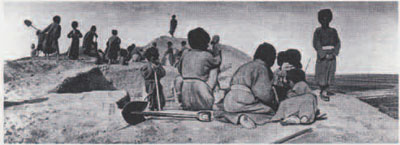
Before the Russian Revolution, a seventy-year-old American geologist named Raphael Pumpelly headed up one of the first scientific excavations ever mounted in the Near East. He traveled to the large desert basin of Central Asia, north of Iran, to the site of Anau in Russian Turkestan. Pumpelly was accompanied by a botanist, a zoologist, his geomorphologist son, and a very fine archaeologist, Hubert Schmidt. The expedition, funded by the newly established Carnegie Foundation, was looking for the earliest evidence of farming in that part of the world.
Investigating layers dating to some 5000 years BC, the researchers studied soils, collected artifacts, did phytolith and faunal analyses, and recorded cultural remains through two seasons of excavation in 1903 and 1904. Their pioneering work established the methods for the scientific study of farm from archaeological remains. In 1907 Pumpelly was not permitted to return to Anau, and shortly thereafter the Russian Revolution closed the borders. He subsequently published the results of the two seasons of work in a final report. His claims for early farming and the existence of an early civilization at Anau shocked his colleagues working in Mesopotamia and Egypt, and they rejected both the novel methods and his claims.
Fast forward some nine decades. In the late 1980s, I was a graduate student at Harvard University, working in the Turkmen S.S.R, where I was the first foreigner to excavate since Pumpelly’s time. I was familiar with Pumpelly’s important work at Ana, and wanted to see the site but was not allowed to. In 1993 I finally received permission to visit Anau, then in the newly independent Republic of Turkmenistan. It looked so promising that I returned for the next two years to lead a Peabody Museum excavation along with my former graduate advisor C.C. Lamberg-Karlovsky.

From Raphael Pumpelly, My Reminiscences (1918, New York: Holt)
We were digging not only in the same area as Pumpelly but also in the same Bronze Age layers, and we would occasionally encounter his backfield trenches. We could prove how careful and accurate Pumpelly’s excavations had been by comparing our sections to the illustrations of sections in the 1908 report. We wanted to put his old data in a new context, but most of the artifacts could not be located. Searches in Turkmenistan, the United States, and Russia proved fruitless.
In 1995 while in California giving lectures on the new work at Anau, I serendipitously encountered Pumpelly’s grandson! This gentleman. Raphael Pumpelly III, said that all of his grandfather’s files and papers had been given to the Huntington Library in San Marino. “But where are the artifacts?” I asked. Pumpelly recalled that as a child he had seen “crates of artifacts” in the basement of the family summer house in New Hampshire. Unfortunately, the house had burned twenty years earlier.
I was hired by the University of Pennsylvania in 1996 and reestablished the Anau dig as a Penn project. We had two successful seasons of excavation, collecting samples that would allow us to apply modern techniques of dating and analysis to the earliest layers of the site. But the mystery of Pumpelly’s artifacts continued to nag at me. So in the summer of 1998, along with Raphael Pumpelly III’s daughter Lisa and two graduate students, I decided to try a long shot—digging in the basement of the ruined Pumpelly villa to see if the missing artifacts just might still be there. Assisted by townspeople, including some of Pumpelly’s great-great- grandchildren, we excavated within the sunken cellar hole where Raphael Pumpelly III remembered having seen the crates. We found…nothing.

It was a blow. Sadly, we packed up. The day before our departure from New Hampshire, a neighbor came over, commiserated on our disappointment, then said, “I think you should see this old chest I have.” As it happened, she was also a Pumpelly descendant. When I opened the four-foot-long chest I found, not the elusive artifacts but something almost as good: photographs, typescripts, illustrations, paintings—even an envelope with a spoonful of sand, marked “Sand from the Kara-Kum Desert.” These papers represented the record Pumpelly had created while writing his report on the excavations at Anau.
This unexpected archival treasure trove redeemed the failed New Hampshire mission. It offers a unique insight into the pioneering approach that Pumpelly used in putting material from an excavated site together with its geographical and geological context. Letters and manuscript drafts by his specialist collaborators showed the organization and rationale of the first-ever interdisciplinary archaeological project. Unpublished photos compared to the versions chosen for publication allow us to see Pumpelly’s sense of what was relevant evidence in a new field with few established scientific standards. Most importantly, correspondence in the trunk pointed to the Kunst Kamera Museum in St. Petersburg, Russia, as the repository of the bulk of the Anau artifacts. I had the chance to visit this collection in February 1999 and confirmed that the artifacts still exist and warrant our further study. Currently, we are cataloging the new archives and scanning images into computer files in preparation for their conservation. Raphael Pumpelly was an adventurer who loved to tell stories about his own exploits, and we hope that he would appreciate this most recent adventure into Central Asia’s little-known past.
